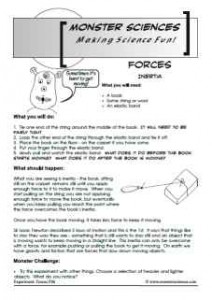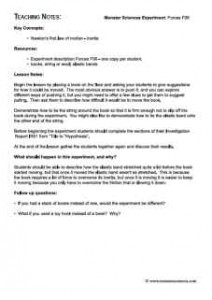Learn about Newton’s 1st law of motion – inertia.
 |
 |
Monster Sciences Experiment: All about inertia
What you will need:
• A book
• Some string or wool
• An elastic band
What you will do:
1. Tie one end of the string around the middle of the book. It will need to be fairly tight.
2. Loop the other end of the string through the elastic band and tie it off.
3. Place the book on the floor – on the carpet if you have some.
4. Put your finger through the elastic band.
5. slowly pull and watch the elastic band. What does it do before the book starts moving? What does it do after the book is moving?
What should happen:
What you are seeing is inertia – the book, sitting still on the carpet, remains still until you apply enough force to it to make it move. When you start pulling on the string you are not applying enough force to move the book, but eventually when you keep pulling you reach the point where the force overcomes the book’s inertia.
Once you have the book moving, it takes less force to keep it moving.
Sir Isaac Newton described 3 laws of motion and this is the 1st. It says that things like to stay they way they are – something that is still wants to stay still and an object that is moving wants to keep moving in a straight line. This inertia can only be overcome with a force, for example pushing or pulling the book to get it moving. On earth we have gravity and friction that are forces that slow down moving objects.
Monster Challenge:
• Try this experiment with other things. Choose a selection of heavier and lighter objects. What do you notice?
TEACHING NOTES: Experiment: Forces F06
Topic: Forces Suitable for Ages: 6 -12+
Key Concepts: inertia – Newton’s first law of motion
Resources:
• Experiment description Forces F06 – one copy per student.
• books, string or wool, elastic bands
Lesson Notes:
Begin the lesson by placing a book on the floor and asking your students to give suggestions for how it could be moved. The most obvious answer is to push it, and you can explore different ways of pushing it, but you might need to offer a few clues to get them to suggest pulling. Then ask them to describe how difficult it would be to move the book.
Demonstrate how to tie the string around the book so that it is firm enough not to slip off the book during the experiment. You might also like to demonstrate how to tie the elastic band onto the other end of the string.
Before beginning the experiment students should complete the sections of their Investigation Report IR01 from ”Title to “Hypothesis”.
At the end of the lesson gather the students together again and discuss their results.
What should happen in this experiment, and why?
Students should be able to describe how the elastic band stretched quite a lot before the book started moving, but that once it moved the elastic band wasn’t as stretched. This is because the book requires a lot of force to overcome its inertia, but once it is moving it is easier to keep it moving because you only have to overcome the friction that is slowing it down.
Follow up discussion questions:
• If you had a stack of books instead of one, would the experiment be different?
• What if you used a toy truck instead of a book? Why?


